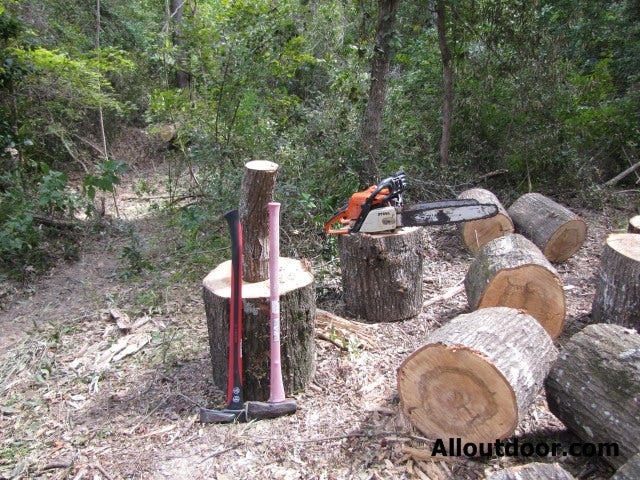Splitting Firewood with Railroad Spikes
Kevin Felts 10.07.16

A couple of months ago a water oak (pin oak) and a live oak fell on the back of the property. This has given me the chance to stockpile some much needed firewood.
While I have all this freshly cut oak firewood, I decided to play around with some ideas. One of those ideas is splitting firewood with railroad spikes. If someone does not have a splitting maul, 8 pound sledge, or wedges laying around, what about railroad spikes?
Railroad spikes are somewhat easy to obtain. Ebay is loaded with them, as are the flea markets, and a vast number of them can be found laying around old farms. In the early days of logging mills, narrow gauge tracks would be built out from the mill in various directions. When the mills closed crews would pick up the tracks. Left behind were numerous bolts, plates, and spikes. Using a metal detector it is common to find spikes left over from these narrow gauge tracks that went out from the mills.
How easy or difficult is it to split firewood with railroad spikes? That is what I set out to answer.
Small oak logs
Five railroad spikes were used in the test, along with some firewood around a foot long and some around 18 inches long. A four pound and eight pound hammer were used to drive the spikes through the wood.
The pin oak logs that were about a foot long came off a tree limb and were around 4-5 inches in diameter. The 18 inch long oak rounds came out of the trunk and were around 18-19 inches diameter.
Splitting the limbs that were around 12 inches long and 4 – 5 inches in diameter with a 4 pound sledge hammer was pretty easy. The railroad spikes made short for of the logs. Any remaining fibers were cut with a machete. Overall I was impressed with the ease that the small logs were split.
Large oak logs
The oak rounds that came out of the tree trunk were a whole different story. The 4 pound sledge hammer was taking too long to drive the spikes, so I switched to an 8 pound sledge. 4 spikes were driven across the face of the oak round, with another spike along the outside of the log. The spikes split the oak log, but not enough to separate it.
To finish the job I used a wedge and the 8 pound sledge to finally separate the oak round into two pieces.
At first I was not impressed with how the railroad spikes did. When I went back the next day to split the large oak rounds from the pin oak tree trunk, an 8 pound splitting maul was bouncing off the wood. Hit after hit did very little to get a crack in the wood started. I beat on those pin oak rounds until I was worn out and did not have the first one split.
What I did not realize at the time, the spikes helped get the oak rounds to split. The spikes started the first crack in the wood, which made using a wedge and maul easier.
When I go back to work on the trees and to split those pin oak rounds, I am going to bring the railroad spikes and give them another try. Splitting the oak round was much easier getting the first crack started with a couple of railroad spikes, then using the maul and wedge.
I am going to go split some more oak firewood and will give another update.
Why Try Railroad Spikes?
Why spend so much time playing around with new stuff?
How else better to learn than to try new things?
Part of life is learning new things. If you stay with only what you know and never try anything new, how are you supposed to learn and grow as a person?
Something else I am thinking about is forging a railroad spike into a wood splitting wedge. Blacksmiths make knives out of railroad spikes, why can’t I put a little more taper on the end and make a small wedge out of it?
The whole purpose is to expand ones knowledge.